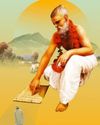
From the song of the koel to the whistling of the winds, the lashing of the waves to the gurgling of a spring, the rustling of the leaves to the pitter-patter of rains - every sound in nature has its unique rhythm. Likewise, the changing colors of the sky, the dazzling sunrises, the dazzling sunsets, and the dark monsoon clouds bring along with them, their own special moods and emotions. These sounds and colors along with the changing seasons have inspired innumerable music composers and poets to pour out their hearts and souls into brilliant compositions. The eagerly awaited monsoon showers, after the scorching heat of summer, have been a recurring theme for romance and celebration.
Our ancient Vedic culture believed in the propitiation of the Rain Gods to bring life to the parched plains of India. The Parjanya Sukta and the Aap sukta (Rig Veda) and the Varuna Sukta (Yajur Veda) were chanted in rhythmic rhetoric meters, set to specific musical notes to bring in the annual onset of rains.
Somewhere, along the way, these musical notes paved the way for a new trend of Monsoon Ragas in the Classical music system of India. Musical composers of ancient India believed that specific notes sung in certain phrases would herald the dark clouds and bring down the showers. The onslaught of the rainy season has inspired a family of at least 36 ragas, classified as Raag Malhaar. Malhar is derived from the Sanskrit words ‘mal’ and ‘haar’ (remover of impurity).
This story is from the July 2020 edition of Rishimukh.
Start your 7-day Magzter GOLD free trial to access thousands of curated premium stories, and 8,500+ magazines and newspapers.
Already a subscriber ? Sign In
This story is from the July 2020 edition of Rishimukh.
Start your 7-day Magzter GOLD free trial to access thousands of curated premium stories, and 8,500+ magazines and newspapers.
Already a subscriber? Sign In
Feel Grateful And Be Happy
Teens & Kids
Q & A ith Gurudev
When we fail, who is the doer?

Bhågåwåt Gïtå
The Song of the Divine

THE PURSUIT OFHAPPINESS
A classic example of how you can thrive during times of pain and adversity and emerge a winner in your own right

SINDHU DARSHAN A TRIBUTE TO INDIA
The festival of Sindhu Darshan is an evocative and endearing celebration to honour the River Sindhu and promote ethnic diversity of India

Epitome of Knowledge SIDDHAR BOGAR
One of the 18 siddha purushas of the siddha lineage in South India, Bogar was a great mystic with unique miraculous powers and had incredible knowledge in a variety of fields and disciplines. We bring you a glimpse of this great yogi’s extraordinary feats.
YOGA The Life Jacket of Strength & Solace
Meditation happens, you can’t do it. You can only create a congenial atmosphere for it to happen.

Nearer than the Nearest
DIDI WRITES

The Real Source of Knowledge
What must a seeker embrace to gain Absolute Knowledge? Read on...

“I FOUGHT COVID AND WON A LOSING BATTLE!”
READERS SPACE